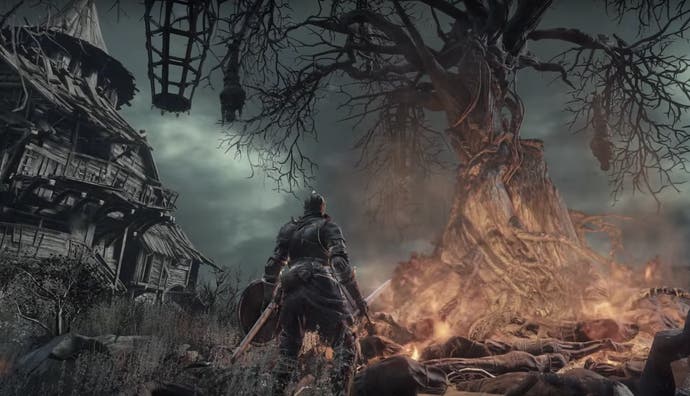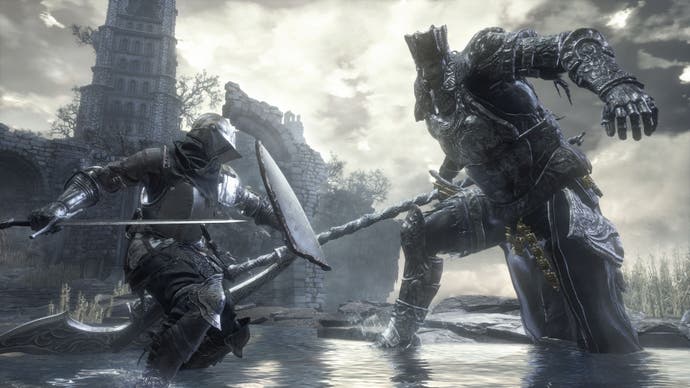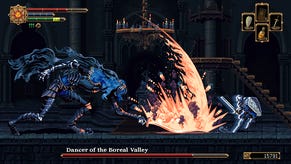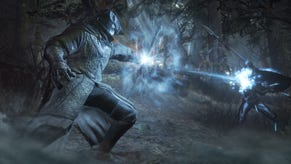28 hours with Dark Souls 3's Japanese PS4 import
May strength be granted.
Editor's note: Our full Dark Souls 3 review will go up next week wherein veteran Souls aficionado Rich Stanton will evaluate From Software's latest action-RPG outing, and we should be able to offer you impressions soon. Until then, Jeffrey has been having a go of the Japanese version on PlayStation 4. Here are his thoughts after 28 hours with the import.
The feel of a Dark Souls game's combat is vital and boy does Dark Souls 3 feel good. In many ways From Software's latest sequel hasn't shaken things up too drastically from the series' prior iterations, but the pace of combat is noticeably swifter. Clearly the friskier fisticuffs from From's previous outing Bloodborne have had an influence, buts it's effortlessly merged with the more considered approach favoured by oldschool "Souls" titles.
Enemies attacks are fast, but you're faster. Healing in other Dark Souls games was applied via a comically long animation, but now a quick guzzle of your Estus flask puts you right back into the fray more immediately than you're used to. The ability to block feels like coming home after Bloodborne threw out the rules of how these games operate, yet your foes are bigger, stronger, and more aggressive to make up for this speedier take on the famously sadistic series. The flow of Dark Souls 3's combat is arguably its finest addition to the franchise and it's even better when you're applying your own fighting style against other human players who have no doubt found their own flavour of battle.
My only qualm with Dark Souls 3's combat - and brace yourself for this one - is that I'm finding it disconcertingly easy relative to its predecessors. It's possible that I'm simply too well-versed in the series to gauge how others will adapt, but only a couple of bosses have taken me more than a few attempts (and that's with refusing to summon help). Some will welcome this accessibility, though I miss the days of struggling to slay Ornstein & Smough solo for several hours. Your mileage may vary, but I worry veteran players may breeze through this more smoothly than they'd like. Hopefully the end game and New Game+ will address this.

In terms of its world, Dark Souls 3 is a sideways step for the series rather than an outright improvement or backpedal. Dark Souls 2's divisive decision to allow fast-travel from the get-go has returned. This provides convenience at the expense of those "wow" moments in the first Dark Souls or Bloodborne where you'd realise the seemingly sprawling world was actually a tightly-woven interconnected series of nodes. On the plus side, each individual area is fairly open-ended, with plenty of room to get lost as you comb their labyrinthine layouts for secrets. And indeed, there are a lot of secrets with whole areas and bosses you can easily miss.
The art direction, which has always been a highpoint of the series, runs the gamut from awe-inspiring to disappointingly derivative of previous iterations. The lion's share of the game looks lovely; the gothic architecture, grossly incandescent beams of light, and varied creature design offers a world both tantalising and terrifying. From the fine details like a derelict village full of rotting wooden corpses seemingly hollowed into trees, to the larger scale of a colossal moonlit cityscape, Dark Souls 3 shows why From is among the best in the biz at concocting dazzling vistas. It's certainly made me pause to capture a screenshot more than any other game since Bloodborne.
However, there are a few spots where this pristine sheen is noticeably absent. A couple of interior cave areas - one of which is rather large - look dispiritingly similar to Bloodborne's procedurally-generated Chalice Dungeons. Anyone who spent more than an hour in those optional gauntlets can tell you that their identikit layouts and banal architecture ran out their welcome quickly and it's disappointing to see such sights rear their ugly head smack dab in the middle of an otherwise inspired adventure. Dark Souls 3 has also suffered a little from its predecessor's lighting problem where everything is just a little too bright. I bought a torch, but haven't once had to use it.
Elsewhere, references to older Dark Souls games toe the line between welcomed nostalgia and prosaic familiarity. One of the original Dark Souls' greatest virtues was its element of surprise. Even if you'd played Demon's Souls and had a grasp of how its basic systems worked, Dark Souls delighted in showering the player with new and unpredictable sights. Running into a fan-favourite character mysteriously resurrected for this sequel - or finding a room whose architecture mirrors that of a famous location in a previous title - offers a cozy feeling of recognition at the expense of shocking the player with something brand new.
There is plenty that is new, however, and I'm reluctantly biting my tongue to gush about it all. The Covenant system has returned and many are delightful to discover with strange one-of-a-kind setpieces marking their shrine. Happening upon a secret altar remains a joy and there's at least a few unusual boss encounters that hearken back to the Demon's Souls days of mixing up how each fight works. These greater demons in particular are a noticeable improvement on Dark Souls 2's largely uninspired collection of knights.
One fine addition I can detail is the hub world, Firelink Shrine, which offers a throwback to the dynamic safe haven of Demon's Souls Nexus. NPCs will appear and disappear, provide new quests, and sometimes perish for reasons unknown. It gives players a reason to poke about this place every now and again when making a pitstop to level up (which can only be done in this one location).
If I sound overly nitpicky about Dark Souls 3 that's only because From is following up three of my all-time favourite games (and the pretty good Dark Souls 2), so anything less than perfection is bound to be scrutenised. At the end of the day, Dark Souls 3 is astonishingly entertaining. It feels overly beholden to fan expectations at times - and some of the cave systems reek of a rushed development - but by and large From has delivered an admirable sequel to a beloved franchise - and one that improves on Dark Souls 2 in almost every way. From may do its best work when freed from the franchise mentality, but Dark Souls 3 still feels like a sweet goodbye to one of gaming's most influential series. I'm certainly looking forward to digging deeper into its final acts.

Lost in translation:
Curious what it's like to import the game in Japanese? It's important to note that the voice acting is in English, so the general thrust of the plot can be understood - so much as the storytelling can ever be understood in a Souls game. The hurdle is that all the text and menus are in Japanese (unless you're playing on Xbox One, in which case there's a region-switching workaround for that).
In truth, this is actually much less of a problem than I anticipated. The first couple of hours were slow-going as I was constantly stopping to look up translated screens of the character creator, menus, and NPC dialogue options. But after sorting the basics, I pretty much only had to resort to a fan translation when picking up a new, weird item. And hey, there's a handy site for that.
Much of this is due to the fact that the menu system carries over from previous Souls titles. Even if the equipment screens are full of stats, your familiarity with the layouts and icons will clue you in on what everything means with minimal cross-checking. As far as dialogue selections go, most NPCs just offer options for shopping and/or ask "yes" or "no" questions wherein the default option is always "yes". You also never forfeit anything without hitting a confirm button, so you're generally free to explore a set of NPC interactions without cause for alarm.
There are a few niggling issues with not understanding the language (well, not much. I took some Japanese in college, but have forgotten almost all of it). The image-based translated item list I've defaulted to has some missing spots. As such, I have a few rings where I don't know what they do, so I just live without them. But generally when I can't find an item I search for it in my inventory to see what category it's part of and the rest I can deduce. "Oh, this is a key item. Let me ask the NPCs at Firelink Shrine if anyone's missing a burnt tome. Huh, pyromancer guy, you're looking for this? Cool. Take it. I wasn't doing anything with it anyway."
While it's weird not knowing the names of areas or bosses (though english Trophies reveal this to me after I've slain a boss), the core loop of gathering goodies and only scrutinising the descriptions of more esoteric fare is remarkably similar to how I play these games in english. I'm definitely missing some minutia (I've not been checking the descriptions of gear), so I look forward to getting the full scoop once the international release ships in a couple of weeks. But even in a foreign tongue the experience of venturing through Lothric remains remarkably intact.
One final note about the PS4 Japanese version: The X and O buttons are switched. O is the "examine" button and confirms menu selections, while X means "cancel" and doubles as the dodge/run button. I adapted to this very quickly (and may even have preferred this layout), but it does take some getting used to when your muscle memory from other Souls games betrays you.
If you decide to import Dark Souls 3 on PS4, here's a rundown of where you'll find translation help.
















.jpg?width=291&height=164&fit=crop&quality=80&format=jpg&auto=webp)